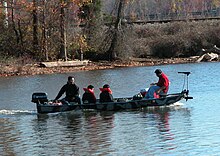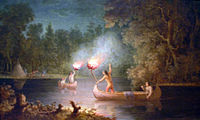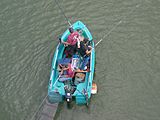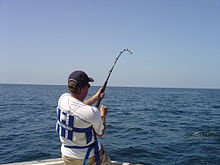Recreational vessels
Big game fishing started as a sport after the invention of the motorized boat. Charles Frederick Holder, a marine biologist and early conservationist, is credited with founding the sport in 1898.[52] Purpose built game fishing boats appeared shortly after. An example is the Crete, in use at Cataline Island, California, in 1915, and shipped to Hawaii the following year. According to a newspaper report at that time, the Crete had "a deep cockpit, a chair fitted for landing big fish and leather pockets for placing the pole."[53]
It is difficult to estimate how many recreational fishing boats there are, although the number is high. The term is fluid, since most recreational boats are also used for fishing from time to time. Unlike most commercial fishing vessels, recreational fishing boats are often not dedicated just to fishing.
- Fishing kayaks have gained popularity in recent years. The kayak has long been a means of accessing fishing grounds.
- Pontoon boats have also become popular in recent years. These boats allow one or two fishermen to get into small rivers or lakes that would have difficulty accommodating larger boats. Typically 8–12 ft in length, these inflatable craft can be assembled quickly and easily. Some feature rigid frames derived from the white water rafting industry.
- Bass boats are small aluminium or fibreglass boats used in lakes and rivers in the U.S. for fishing bass and other panfish. They have swivel chairs for the anglers, storage bins for fishing tackle, and a tank with recirculating water for caught fish. They are usually fitted with an outboard motor and a trolling motor.
- Charter boats are often privately operated, purpose-built fishing boats, and host fishing trips for paying clients. Their size can range widely depending on the type of trips run and the geographical location.
- Freshwater fishing boats account for approximately one third of all registered boats in the USA. Most other types of boats end up being used for fishing on occasion.
- Saltwater fishing boats vary widely in size and can be specialized for certain species of fish. Flounder boats, for example, have flat bottoms for a shallow draft and are used in protected, shallow waters. Sport fishing boats range from 25 to 80 feet or more, and can be powered by large outboard engines or inboard diesels. Boats used for fishing in cold climates may have space dedicated to a cuddy cabin or enclosed wheelhouse, while boats in warmer climates are more likely to be open.
- Fly fishing from a dinghy
Recreational boat fishing
Inshore
Inshore boat fishing is fishing from a boat in easy sight of land and in water less than about 30 metres deep. The boat can be as small as a dinghy. It can be a row boat, a runabout, an inflatable or a small cabin cruiser. Inshore boats are typically small enough to be carried on a trailer, and are much more affordable than offshore fishing boats. In recent times fishing from a kayak has become popular.Anglers either use an uptide rod between 9 and 10 feet in length to cast from the boat or a shorter downtide rod between 6 and 8 feet. Lines are usually between 18 pounds and 50 pounds breaking strain dependent on the species of fish being targeted. Reels are usually multipliers, although fixed spool reels are being used more and more. Baits are similar to those used for beach and rock fishing except they are often larger since larger fish are targeted. The species will include all the beach species, but now also include big conger eels and small sharks like tope and smoothhound.
- Fishing dingy in Switzerland
- Fishing from a boat on the Doubs River, France
- An angler in a float tube plays a pike.
Offshore
Offshore boats are generally much larger than inshore boats, and may need to be moored in a marina. They are sturdily constructed so they can brave the weather and water conditions encountered in open waters. Though they differ in design and purpose and prices vary widely they are generally expensive to build and maintain. Most offshore recreational fishermen charter boats rather than own them. It is often a pastime of the affluent, and there is a demand for charter boats equipped and catered to luxurious excess.
Offshore game fish, like marlin and tuna, can be very large and heavy tackle is needed. Fishing is usually done with sea rods, such as downtide rods, with lines of 30 to 50 pounds and multiplier reels. Baits are the same as for inshore fishing and include squid and whole mackerel as well as artificial lures such as perks. Fishing takes place over reefs and wrecks for very large cod, ling and congers.
- Small sport fishing boat
- Larger charter boat in Bermuda
- /
- On the bridge of a sport fishing boat in Long Island Sound
Source: http://en.wikipedia.org/
More Stories: http://blackboxfishtalk.blogspot.com/















No comments:
Post a Comment